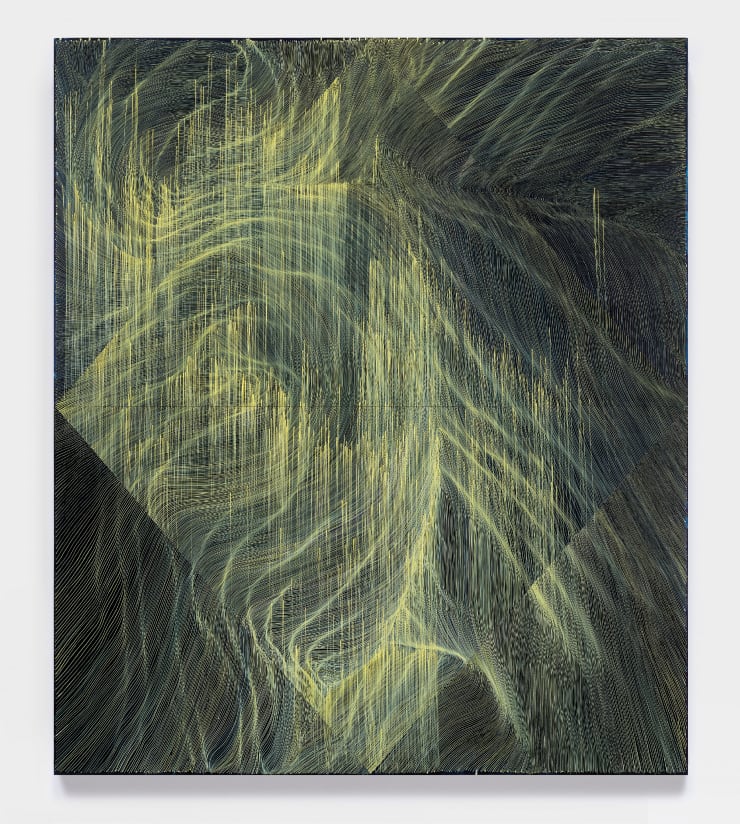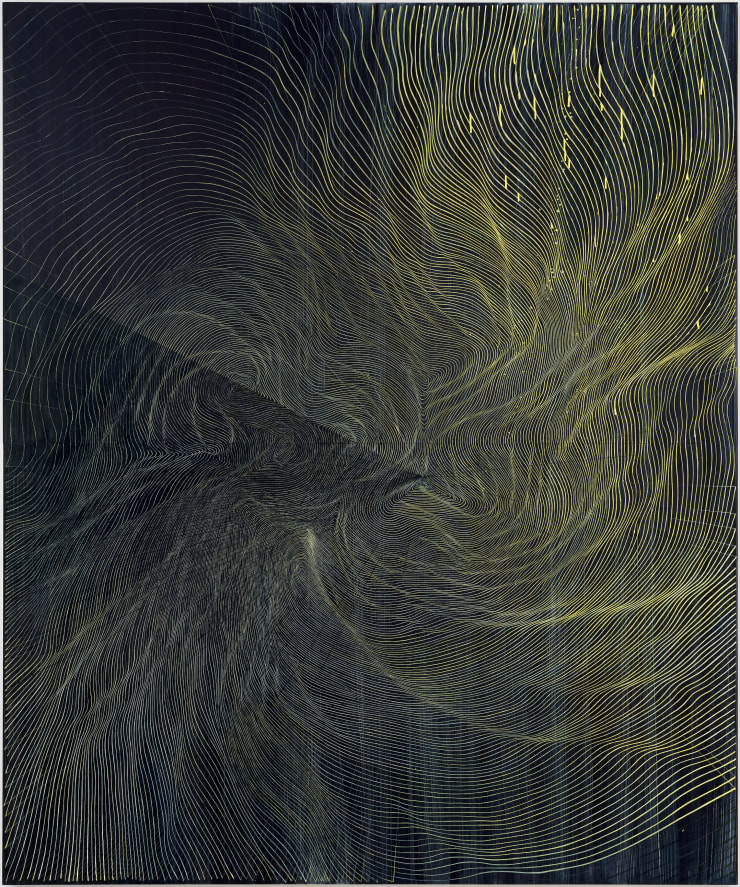linn meyers: Rings of Saturn
Jason Haam is pleased to present linn meyers: Rings of Saturn, the first solo exhibition of linn meyers with the gallery in Seoul, South Korea. Referencing W. G. Sebald’s book of the same name, the title of the exhibition acts as a form of mimesis through correspondence between the visual image within meyers’ physical work and the fragmented narrative within Sebald’s distinctive prose.
For linn meyers, process begins before the act of mark-making. The artist’s physical movement towards the work itself becomes a part of process—similar to the moment of distinction between walking towards the walk and the walk itself. It is in this way that the origin of her works is contextualized not only through the manifestation of the visual image, but also through the immateriality of movement.
The sense of a diverted movement that is nonetheless a movement forward, a movement alongside yet oblique path toward an end, is divided, and more than once. There is the sense of the pilgrimage as devotional journey to a sacred destination and then the sense of pilgrimage as an event of endless wandering, an itinerancy without any clear path toward outcome
-Lecia Rosenthal, “On the Late Sublime: W. G. Sebald’s The Rings of Saturn”
While visual forms may end at the periphery of meyers’ works, manifestations of process, as a form of movement, continue beyond the work itself—emerging as a record of her pilgrimage. For meyers, a state of finality is negated through its paradox—a memory of movement within the spatial limitations of the physical work.
The entropic yet methodical image of meyers’ works, exists within a state of visual equilibrium, maintained through a state of perpetual movement. Its resolution is dependent upon a sense of perspective. Meyers’ process is defined by intuitive gestures, in which the visual image emerges from a progressive digression of movement—directed by a sense of ‘nonobjective wandering.’ Simultaneously, meyers’ visual image is defined by a sequential organization, in which process emerges from regressive patterns of movement—delineated from a sense of ‘nonobjective wandering.’ Herein lies the paradox of movement within the visual image—the awareness of a systematic order within an experience of chaotic destabilization.
Order is, at one and the same time, that which is given in things as their inner law, the hidden network that determines the way they confront one another, and also that which has no existence except in the grid created by a glance, an examination, a language; and it is only in the blank spaces of this grid that order manifests itself in depth as though already there, waiting in silence for the moment of its expression
-Michel Foucault, “The Order of Things”
Hence, the paradox of movement can exist only in reference to the grid—the context in which one and one other exists only in reference to themselves. Movement, without regard to a sense of destination or finality, emerges as a state of contingency—the absence of necessity; the fact of being so without having to be so.
A state of finality can thus only be achieved through the visual image of the work itself. Process becomes a means of documenting the physical movement of the body. In this way meyers’ exploration becomes displaced by the visual image of her works. The resulting image emphasizes the distinction between her body as a construct of process and creator of movement and the work as an embodiment of process and a document of past movement. Herein lies the paradox that exists throughout meyers’ works—the visual image is contextualized in reference to the body as movement, yet the works themselves manifest a state of finality.
And thus, the resulting state of contingency within meyers’ works—in which both movement and finality exist within an oscillating state of uncertainty—becomes a paradox in and of itself.
제이슨함은 2019년의 첫 개인전으로 linn meyers의 개인전 을 선보인다. 본 전시는 작가의 서울에서의 첫 개인전으로 W. G. Sebald의 동명의 소설을 전시의 제목으로 인용한다. 토성의 고리는 meyers의 반복적인 작업과 Sebald의 분절된 서사시 사이를 잇고 둘은 서로 모방의 은유로 공명한다.
Meyers는 점과 선, 색을 반복적으로 사용하며 평면을 채워나간다. 기하학적이나 풍경처럼 보이는 불규칙적인 선형의, 그리고 곡선형의 형상들은 단순한 드로잉이나 추상적 패턴의 담론을 벗어난다.
Meyers의 작업은 과정과 시간의 예술이다. 가장 기본적인 예술의 질료들은 작가의 신체를 통해 응용되고 반복되며, 작가가 평면을 마주하고 공간에서 시간을 보내며 손으로 새기는 모든 신체적 움직임(movement)의 결과물이다. 일련의 신체적인 과정으로서 그녀의 작업은 어쩌면 수행, 구도(求道), 혹은 기록의 순례(record of pilgrimage)인지 모른다. 일정한 완결에 다다를 때까지 계속되는 ‘표식 만들기’(act of mark-making)가 남기는 표시들은 나이테처럼 meyers가 머물렀던 시공간과 작가의 신체의 기록이다.
작가가 남기는 표시들은 응집되어 이미지를 만들어낸다. 이는 고정되어 있으면서도 끊임없이 움직이고, 질서정연하면서도 혼란스러우며 완전과 불완전을 동시에 지니고 있다. 이러한 시각적 이미지와 움직임의 역설은 meyers 작업의 우연적 특징에 기인한다. 신체적 움직임을 기록하는 작가의 창작 과정에는 뚜렷한 목적이 부재한다. 일정한 목표와 계획에 따라 그려나가는 것이 아닌, 우연의 상태 자체에 대한 기록인 셈이다. 필연이 부재하는 평면 안에서 혼돈과 불안정을 기반으로 생성되는 이미지에는 작가가 미처 떨치지 못한 무의식적 패턴이나 체계적 질서에 대한 인식이 남아있다. 도출되는 이미지는 따라서 체계적이지만 동시에 무질서하다. 작가의 신체가 과정이 되어 재현의 형식으로 작품에 습합되는 한편, 작품은 그 과정의 신체적 구현이며 움직임의 기록이 되는 역설에 놓이는 것이다.
이처럼 meyers의 수행적인 기록 과정은 시공간과 신체의 움직임에 대한 가장 순수한 고찰인지 모른다. 표식을 반복적으로 새기는 과정을 통해 결과물로서 평면에는 움직임의 찰나가 담기고 움직임은 평면의 한계를 넘어 계속된다. 이로써 작가의 작품은 살아 숨쉬며, 분절된 순간들의 연속체로 존재한다. 요동치는 듯 보이는 평면은 단순한 시각적 교란을 넘어, 보다 복합적인 과정의 산물이다. 균일해보이지만 가까이 다가서면 유기적인 선들, 흘리기의 사용 등 인간적인 흔적을 발견하면서 공간적이고 수행적인 감상으로 나아간다. 작가의 개인적이고 신체적인 평면과의 독대의 과정은 고스란히 작품으로 남고, 감상자 역시 이를 시각적으로, 또 신체적으로 체험하게 되는 것이다.







